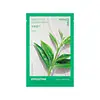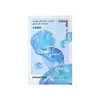What's inside
What's inside
 Key Ingredients
Key Ingredients

 Benefits
Benefits

 Ingredients Side-by-side
Ingredients Side-by-side

Water
Skin ConditioningButylene Glycol
HumectantDipropylene Glycol
HumectantGlycerin
HumectantGlyceryl Polymethacrylate
Ceramide AP
Skin Conditioning1,2-Hexanediol
Skin ConditioningPolyglyceryl-10 Laurate
Skin ConditioningCarbomer
Emulsion StabilisingArginine
MaskingGlyceryl Caprylate
EmollientXanthan Gum
EmulsifyingEthylhexylglycerin
Skin ConditioningCamellia Sinensis Leaf Extract
AntimicrobialPaeonia Suffruticosa Root Extract
Skin ProtectingCentella Asiatica Extract
CleansingDisodium EDTA
Chamomilla Recutita Flower Extract
MaskingRosa Damascena Flower Water
MaskingPyrus Communis Fruit Extract
Skin ConditioningCucumis Melo Seed Extract
Skin ConditioningDiethylhexyl Sodium Sulfosuccinate
CleansingIris Florentina Root Extract
MaskingSodium Hyaluronate
HumectantVetiveria Zizanoides Root Oil
MaskingWater, Butylene Glycol, Dipropylene Glycol, Glycerin, Glyceryl Polymethacrylate, Ceramide AP, 1,2-Hexanediol, Polyglyceryl-10 Laurate, Carbomer, Arginine, Glyceryl Caprylate, Xanthan Gum, Ethylhexylglycerin, Camellia Sinensis Leaf Extract, Paeonia Suffruticosa Root Extract, Centella Asiatica Extract, Disodium EDTA, Chamomilla Recutita Flower Extract, Rosa Damascena Flower Water, Pyrus Communis Fruit Extract, Cucumis Melo Seed Extract, Diethylhexyl Sodium Sulfosuccinate, Iris Florentina Root Extract, Sodium Hyaluronate, Vetiveria Zizanoides Root Oil
Water
Skin ConditioningButylene Glycol
HumectantGlycerin
HumectantDipropylene Glycol
Humectant1,2-Hexanediol
Skin ConditioningAllantoin
Skin ConditioningArginine
MaskingCarbomer
Emulsion StabilisingPolyglyceryl-10 Laurate
Skin ConditioningGlyceryl Caprylate
EmollientEthylhexylglycerin
Skin ConditioningLimnanthes Alba Seed Oil
Skin ConditioningAcrylates/C10-30 Alkyl Acrylate Crosspolymer
Emulsion StabilisingCaprylic/Capric Triglyceride
MaskingHydroxyethylcellulose
Emulsion StabilisingStyrene/Acrylates Copolymer
Sodium Phytate
Polyglyceryl-3 Methylglucose Distearate
EmulsifyingHydrogenated Lecithin
EmulsifyingMethyl Glucose Sesquistearate
EmollientCetearyl Glucoside
EmulsifyingSodium Hyaluronate
HumectantHouttuynia Cordata Extract
Skin ConditioningMelaleuca Alternifolia Leaf Extract
PerfumingArtemisia Princeps Leaf Extract
Skin ConditioningTocopherol
AntioxidantPolysorbate 60
EmulsifyingDisodium Phosphate
BufferingHydroxypropyltrimonium Hyaluronate
Sodium Phosphate
BufferingHydrolyzed Hyaluronic Acid
HumectantSodium Acetylated Hyaluronate
HumectantHyaluronic Acid
HumectantSodium Hyaluronate Crosspolymer
HumectantHydrolyzed Sodium Hyaluronate
Skin ConditioningPotassium Hyaluronate
Skin ConditioningWater, Butylene Glycol, Glycerin, Dipropylene Glycol, 1,2-Hexanediol, Allantoin, Arginine, Carbomer, Polyglyceryl-10 Laurate, Glyceryl Caprylate, Ethylhexylglycerin, Limnanthes Alba Seed Oil, Acrylates/C10-30 Alkyl Acrylate Crosspolymer, Caprylic/Capric Triglyceride, Hydroxyethylcellulose, Styrene/Acrylates Copolymer, Sodium Phytate, Polyglyceryl-3 Methylglucose Distearate, Hydrogenated Lecithin, Methyl Glucose Sesquistearate, Cetearyl Glucoside, Sodium Hyaluronate, Houttuynia Cordata Extract, Melaleuca Alternifolia Leaf Extract, Artemisia Princeps Leaf Extract, Tocopherol, Polysorbate 60, Disodium Phosphate, Hydroxypropyltrimonium Hyaluronate, Sodium Phosphate, Hydrolyzed Hyaluronic Acid, Sodium Acetylated Hyaluronate, Hyaluronic Acid, Sodium Hyaluronate Crosspolymer, Hydrolyzed Sodium Hyaluronate, Potassium Hyaluronate
 Reviews
Reviews

Ingredients Explained
These ingredients are found in both products.
Ingredients higher up in an ingredient list are typically present in a larger amount.
1,2-Hexanediol is a synthetic liquid and another multi-functional powerhouse.
It is a:
- Humectant, drawing moisture into the skin
- Emollient, helping to soften skin
- Solvent, dispersing and stabilizing formulas
- Preservative booster, enhancing the antimicrobial activity of other preservatives
Arginine is an amino acid that is important for human development. Your body uses is it to produce hair keratin and skin collagen.
As a cosmetic ingredient, Arginine has antioxidant properties and can also help repair damaged skin. This ingredient is derived either synthetically or from animals.
Arginine isn't fungal acne safe when used in the presence of other lipids (fats, fatty acids, oils, esters, etc). Oils and fats occur naturally within the skin, so take caution when using Arginine if you're prone to fungal acne.
Learn more about ArginineButylene Glycol (or BG) is used within cosmetic products for a few different reasons:
Overall, Butylene Glycol is a safe and well-rounded ingredient that works well with other ingredients.
Though this ingredient works well with most skin types, some people with sensitive skin may experience a reaction such as allergic rashes, closed comedones, or itchiness.
Learn more about Butylene GlycolCarbomer is a polymer of acrylic acid. Its main role is to create a gel consistency.
A high amount of carbomer can cause pilling or balling up of products. Don't worry, most products contain 1% or less of carbomer.
Dipropylene Glycol is a synthetically created humectant, stabilizer, and solvent.
This ingredient helps:
Dipropylene glycol is technically an alcohol, but it belongs to the glycol family (often considered part of the ‘good’ alcohols). This means it is hydrating and gentle on skin unlike drying solvent alcohols like denatured alcohol.
As a masking agent, Dipropylene Glycol can be used to cover the smell of other ingredients. However, it does not have a scent.
Studies show Dipropylene Glycol is considered safe to use in skincare.
Learn more about Dipropylene GlycolEthylhexylglycerin (we can't pronounce this either) is commonly used as a preservative and skin softener. It is derived from glyceryl.
You might see Ethylhexylglycerin often paired with other preservatives such as phenoxyethanol. Ethylhexylglycerin has been found to increase the effectiveness of these other preservatives.
Glycerin is already naturally found in your skin. It helps moisturize and protect your skin.
A study from 2016 found glycerin to be more effective as a humectant than AHAs and hyaluronic acid.
As a humectant, it helps the skin stay hydrated by pulling moisture to your skin. The low molecular weight of glycerin allows it to pull moisture into the deeper layers of your skin.
Hydrated skin improves your skin barrier; Your skin barrier helps protect against irritants and bacteria.
Glycerin has also been found to have antimicrobial and antiviral properties. Due to these properties, glycerin is often used in wound and burn treatments.
In cosmetics, glycerin is usually derived from plants such as soybean or palm. However, it can also be sourced from animals, such as tallow or animal fat.
This ingredient is organic, colorless, odorless, and non-toxic.
Glycerin is the name for this ingredient in American English. British English uses Glycerol/Glycerine.
Learn more about GlycerinGlyceryl Caprylate comes from glycerin and caprylic acid, a fatty acid from coconut. It has emollient and emulsifier properties.
As an emollient, it helps hydrate your skin. Emollients work by creating a barrier on your skin to trap moisture in, helping to keep your skin soft and smooth.
On the other hand, emulsifiers prevent ingredients (such as oil and water) from separating.
Learn more about Glyceryl CaprylatePolyglyceryl-10 Laurate is an ester of lauric acid and Polyglycerin-10.
Polyglyceryl-10 Laurate is a cleansing agent and emulsifier. It helps gather dirt, oil, and other pollutants to be rinsed away. As an emulsifier, it helps prevent ingredients from separating, such as oil and water.
Polyglyceryl-10 Laurate may not be fungal acne safe.
Learn more about Polyglyceryl-10 LaurateSodium Hyaluronate is hyaluronic acid's salt form. It is commonly derived from the sodium salt of hyaluronic acid.
Like hyaluronic acid, it is great at holding water and acts as a humectant. This makes it a great skin hydrating ingredient.
Sodium Hyaluronate is naturally occurring in our bodies and is mostly found in eye fluid and joints.
These are some other common types of Hyaluronic Acid:
Learn more about Sodium HyaluronateWater. It's the most common cosmetic ingredient of all. You'll usually see it at the top of ingredient lists, meaning that it makes up the largest part of the product.
So why is it so popular? Water most often acts as a solvent - this means that it helps dissolve other ingredients into the formulation.
You'll also recognize water as that liquid we all need to stay alive. If you see this, drink a glass of water. Stay hydrated!
Learn more about Water